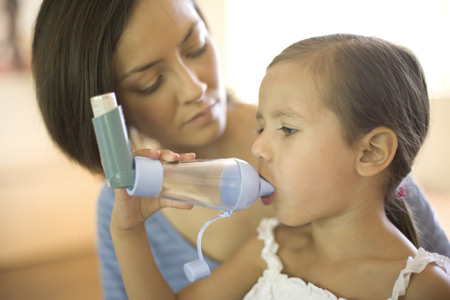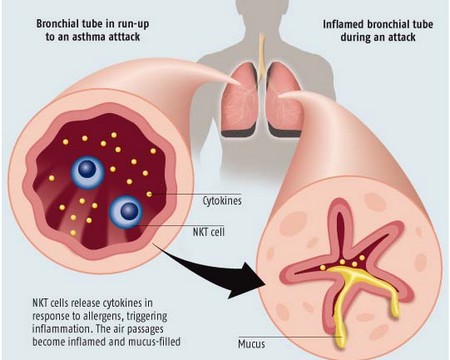Asthma is a common disease, and its occurrence is growing due to factors such as increasingly poor air quality and growing incidence of food intolerance thought to be related to the use of pesticides and drugs. About one in seven children suffer. It is commonly caused by allergens such as pollen, house-dust, animals or feathers. An allergic reaction to these allergens causes breathlessness and wheezing as the bronchioles – the small airways in the lung – narrow. Mucus secretion also increases, which further blocks the airways. Exercise, emotional upset, smoke or an infection can also cause an attack. Your child is also more likely to suffer if asthma or a related allergy such as eczema or hayfever runs in the family.
Some asthma attacks may be mild while others are severe. During an attack, children can become very distressed as they fight for breath, making the problem worse. They may cough to try and remove the mucus and may go blue around the lips due to lack of oxygen. Some children have persistent coughing, particularly during the night, especially young children.
What you can do
Identify which allergens are causing problems. In the bedroom, regularly clean the mattress, soft furnishings and curtains and hot wash linens to minimize dust mites. Keep the windows at home and in the car closed during high pollen counts. Eliminate any foods that may be at fault, although this should only be done under supervision. Try to minimize stressful situations, if these are a trigger. And, sad though it may be, if you have pets try to see whether contact with them brings on an attack. Swimming is known to be a good exercise that can strengthen the lungs without too much overexertion.
During an attack, sit your child up, propped up by (non-feather) pillows and try to keep them as calm as possible. If you’re looking anxious yourself this will only transmit to the child.
Treatment
Medical attention should be sought, but the following complementary therapies may also be beneficial:
Traditional Chinese medicine
TCM has proved successful for many asthmatics, with some finding that acupuncture or acupressure have helped reduce attacks. There have been many studies carried out on childhood asthma where acupuncture has, in some cases, significantly improved symptoms. Herbs may also be prescribed to help resolve what TCM sees as weakness in the lung, spleen or kidney and too much phlegm. Other herbs may be given for use during an attack, once the child’s ‘pattern’ of attacks is understood. Other herbs will be given to protect from colds and allergic attacks, such as ginseng, liquorice, angelica and apricot. A diet including plenty of fresh fruit and vegetables, oily fish, garlic and onions and steering clear of refined foods, dairy products and additives and colourings, such as tartrazine, may all help to reduce symptoms.
Naturopathy
This may include a number of therapies. A naturopath may advise a diet that includes fresh vegetables and fruit (but avoiding citrus), wholemeal foods and cutting back or preferably cutting out dairy and refined products. Garlic and onions may be recommended as they are said to help counter the production of mucus, and reducing eating red meat to once or twice a week may be advised. Osteopathy or gentle massage, to help loosen the chest muscles and joints to ease breathing, and a gentle exercise programme to increase respiratory strength may also be advised. Your child will also be assessed for food allergies, for instance to dairy products, wheat or foods containing additives. Mineral salt supplements, such as calcium and magnesium phosphate, may be recommended, to help support the body.
Homoeopathy
One recent study found homoeopathy very successful in treating bronchial asthma. A combination of remedies may be used, but a homoeopath will treat each child as an individual, depending on their particular condition. So, Phosphorus may be given to deal with wheezing and coughing. If your child is affected by dust and the drying effects of central heating and suffers wheezing and shortness of breath, which is worse at night, Kali. Carb. may be prescribed and so on.
Chiropractic
A Chiropractor Edmonton may be able to help with strain and stiffness caused by heavy and difficult breathing. They will correct any stiffness in the joints and muscles of the mid-back and ribcage. This will not only help with the physical effort of breathing but can help stimulate the nervous supply to those joints, muscles and also the lungs.
Osteopathy
An osteopath may be able to improve the workings of the chest and the functions of the spine, ribs and diaphragm through manipulation. Cranial work may also be done to rebalance any interference in the body’s system which controls involuntary actions which may lead to excess mucus secretion, causing congestion and constricted lung tissue.
Caution
During an attack or when symptoms are severe, always consult a doctor. You should always have the prescribed orthodox drugs at home, ready to administer. Once you have discussed your child’s health with a complementary practitioner, you can decide together how to move forward in treating your child’s illness.
Other therapies that may be beneficial: yoga, hypnotherapy, herbal medicine, Alexander Technique, Bach Flower Remedies.

